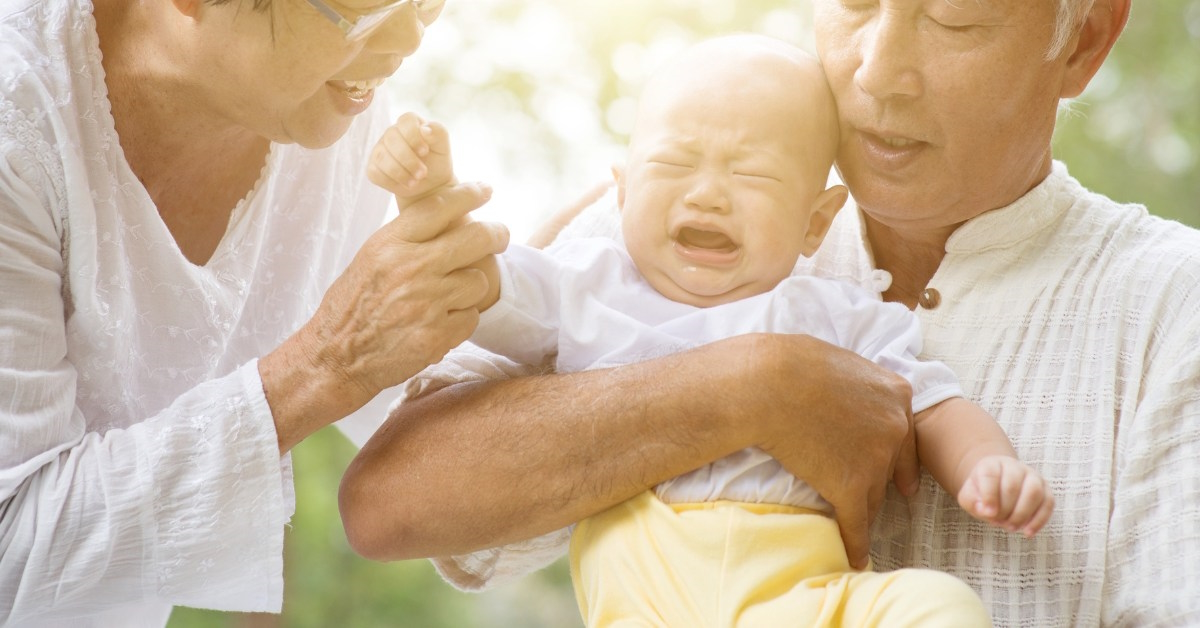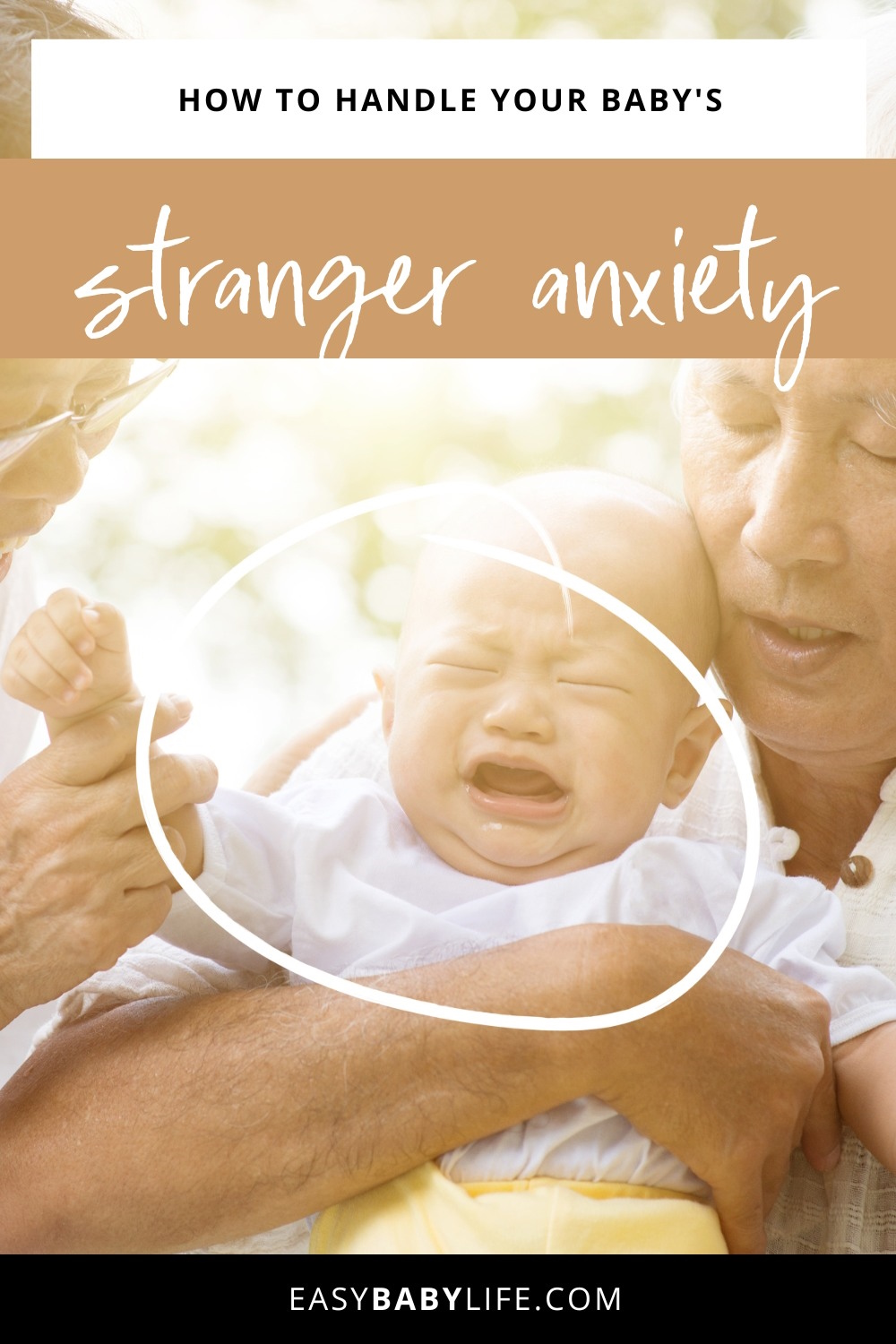“My baby screams if a stranger even just looks at him, even family members! It doesn’t seem normal to be scared so easily! “
Why are some babies so scared of strangers or even of some family members? When is this just a normal part of their development, and when is it a sign that something is not right?
Let’s go through what stranger anxiety really is, at what age to expect it, common symptoms, how to act as a parent, and signs that the anxiety is more than just normal development.

Stranger Anxiety In Babies and Toddlers
When there is a new baby in the family, everyone is excited to see the new bundle of joy. Grandparents, extended relatives, and friends all want a chance to hold the baby and take turns eliciting a smile or laugh. Initially, babies seem to love all this attention, willingly going from person to person without a fuss.
Then, suddenly, they begin to frown, cry, or become quite upset when in the presence of anyone who doesn’t live in their home. This common infant behavior is known as stranger anxiety.
the distress a child feels when an unfamiliar person approaches
What is Stranger Anxiety?
The psychological definition of stranger anxiety is simply the distress a child feels when an unfamiliar person approaches. Stranger anxiety is a normal and expected milestone among infants and toddlers. It is thought to be a protective mechanism and a sign of healthy emotional and cognitive development.
During the first year of life, babies make emotional connections with their parents, siblings, babysitters, and others who are part of their daily lives. Once infants begin to realize that these people are different from everyone else, they show signs of stranger anxiety.
With some babies, you hardly notice this phase, but with others, they literally start crying at all new faces or even voices. Or at least some faces or voices. It can vary with different people, and as an adult, it can be completely impossible to understand why one person is scary, and another one isn’t.
When Should Parents Expect to See Stranger Anxiety?
So, at what age does stranger anxiety start and stop?
In general, infants develop stranger anxiety between seven to 10 months old. Although some infants can have it earlier, most babies will happily engage with anyone throughout the first six months of life. Once stranger anxiety begins, however, it continues throughout the early toddler years. Most toddlers outgrow this developmental phase by age three.
What Are the Signs of Stranger Anxiety?
Typical signs and symptoms of stranger anxiety include:
- Becoming easily distressed by people perceived to be unfamiliar
- Clinging to the parent when unfamiliar people are present
- Refusing to engage with anyone not within the immediate household
- Crying or having a tantrum when seeing someone unfamiliar
Parents may first realize that the baby has developed stranger anxiety during a visit with relatives who live in a separate household. The previously playful interactions are now replaced by crying and resisting being held by grandparents, aunts, and uncles. Other infants may not show signs until their first birthday party, where a large group of friends and relatives have gathered.
Family photos of the baby smiling with a birthday cake are difficult to obtain due to crying and distress. At regularly scheduled well checkups, infants who were initially happy to be examined instead scream, cry, and cling to their parents during these visits.
How Does Stranger Anxiety Affect Interactions With Others?
Stranger anxiety can be challenging for other family members and loved ones. If they have traveled great distances to visit the baby, they may feel disappointed in the limited amount of interaction. This can create some uncomfortable feelings for both the parents and the visitors.
For parents who work outside of the home, introducing their infant or toddler to a daycare environment may initially be challenging. It can take weeks for the baby to adjust to teachers and other staff. Away-from-home activities can also be challenging during the stranger anxiety phase, such as parties, festivals, and other social gatherings. Too many unfamiliar people can result in an upset baby or toddler.
What babies need during this phase is to be with the people they love the most.
What Can Be Done To Reduce Stranger Anxiety?
Experiencing stranger anxiety is unavoidable. What babies need during this phase is to be with the people they love the most. Be gentle with them, cuddle, and try not to overexpose them to the stress of meeting many other people. However, there are a few ways to reduce the severity of the outbursts and help a baby or toddler to feel more comfortable:
- Limit the number of “strangers” per encounter. One or two unfamiliar people is less overwhelming than a group. It gives an opportunity to “warm up” to the new person and increases the chances of a more positive encounter.
- Parents should stay close by. Do not try to “train your baby by asking strangers to hold him or her, and say no to anyone who wants to hold your baby if you believe that it will make your baby uncomfortable. Interactions with unfamiliar (or currently “scary”) people will be more successful if the baby or toddler remains in the parent’s arms so he or she can get used to that person’s looks, voice, or smells while in a safe place (according to your baby). As the comfort level improves, so does the willingness to go to other people.
- Introduce new people gradually. For the first few encounters, it may only be possible to talk or interact at a distance. As familiarity increases over time, the baby or toddler will become more comfortable with close physical contact.
- Know when to take a break. If the level of distress is increasing and the baby becomes difficult to console, it is best to leave the situation and return to a more familiar environment. Although this is not often the desired outcome, it may be best for everyone involved.
When Is It More Than Just Stranger Anxiety?
Although most toddlers outgrow their stranger anxiety by age three, some children continue to be more wary of others. This is more than just a healthy fear of strangers that protects children from dangerous situations or predatory people. Some children are inherently shy and need a bit more time to feel comfortable around less familiar people. With gentle encouragement and positive reinforcement, shy children are able to overcome any hesitation and can engage in a socially appropriate manner.
In contrast, an older child who cries or has tantrums when around anyone outside the household is behavior that differs from normal stranger anxiety. They may instead suffer from separation anxiety, social phobia, or other anxiety disorders. In such cases, a psychological evaluation and therapy can be helpful.
Children with autism can feel overwhelmed among groups of people and may prefer the familiarity of their household setting. However, unlike normal infant or toddler stranger anxiety, concerning symptoms are present. These may include cognitive or developmental delays, difficulty with emotional regulation, and ritualistic behaviors.
Parents who feel that their child has more than just stranger anxiety should speak with their pediatrician.
Takeaway
Stranger anxiety is a normal development phase of babies and toddlers between around seven months and three years.
The thing is, your baby is really starting to understand the difference between closest family and others and between primary caregivers and others. And what the baby defines as “family” may not at all coincide with your definition.
The best way to help your child is to stay close and not push him or her into situations where the anxiety increases.
The more your baby’s needs for safety and reassurance are met, the faster they will get over it.
So you see, your baby’s or toddler’s behavior is actually a good thing; they are growing and making important emotional connections.
Paula
Babies With Stranger Anxiety
References


Paula Dennholt founded Easy Baby Life in 2006 and has been a passionate parenting and pregnancy writer since then. Her parenting approach and writing are based on studies in cognitive-behavioral models and therapy for children and her experience as a mother and stepmother. Life as a parent has convinced her of how crucial it is to put relationships before rules. She strongly believes in positive parenting and a science-based approach.
Paula cooperates with a team of pediatricians who assist in reviewing and writing articles.
Trending Products












